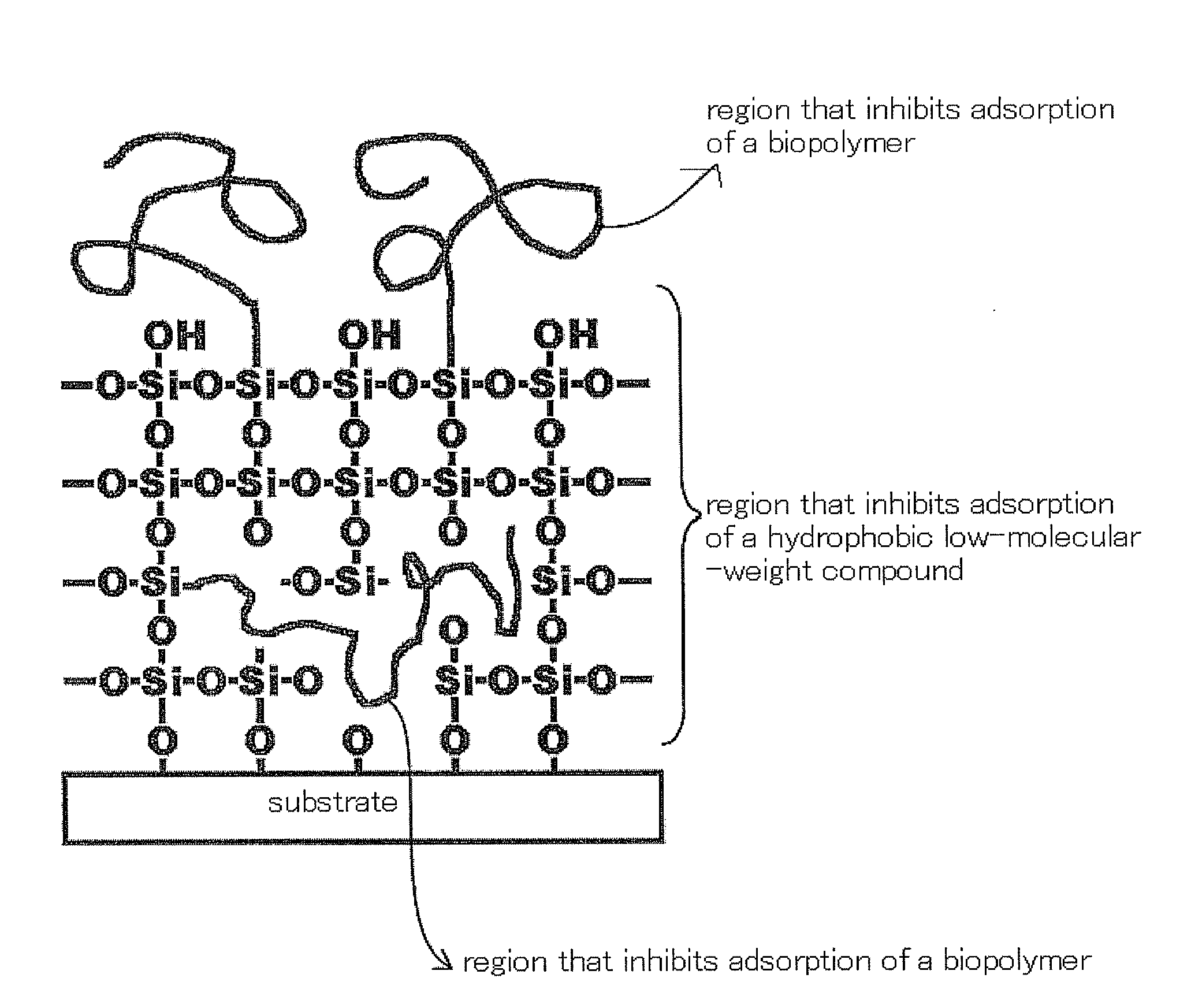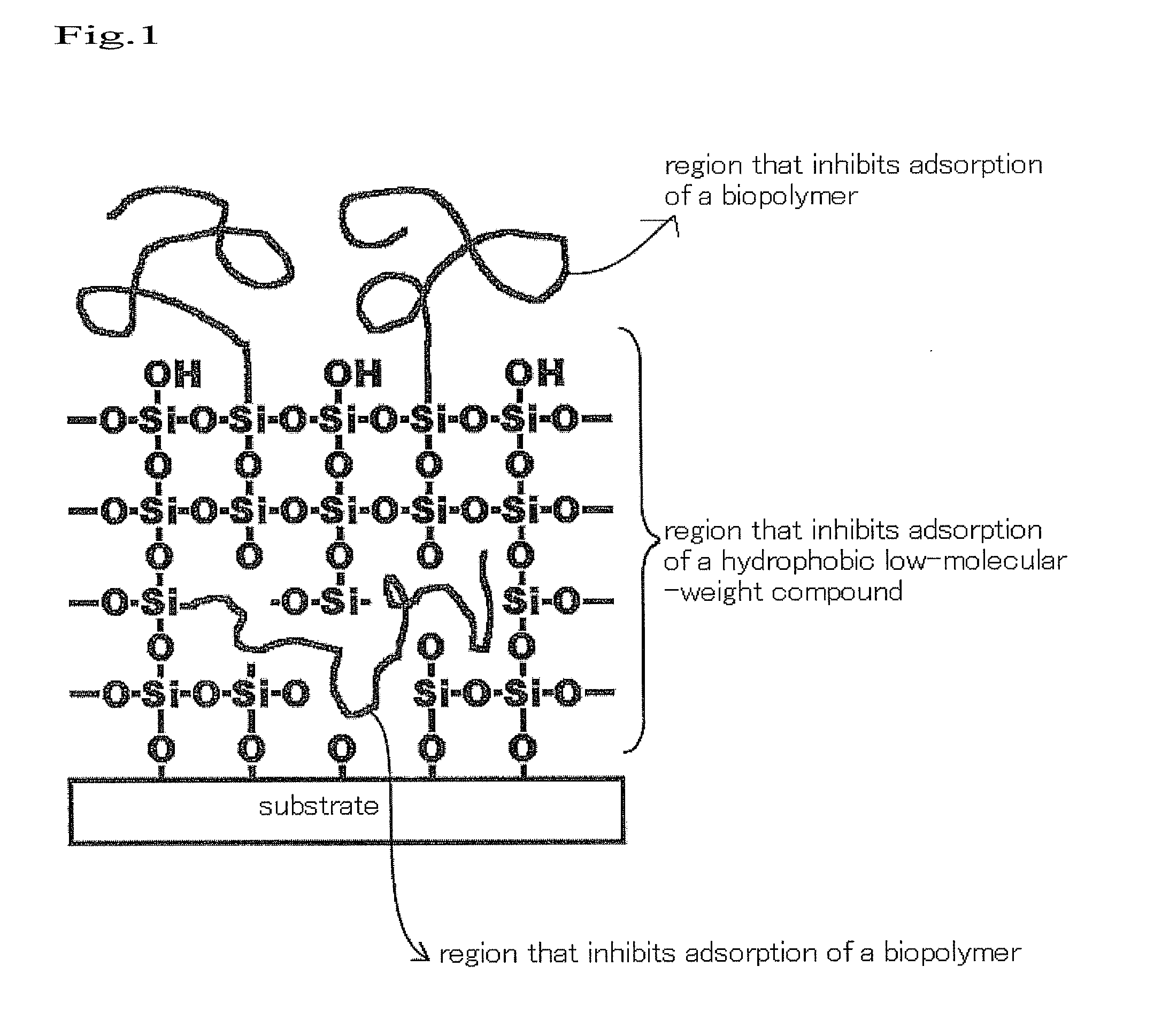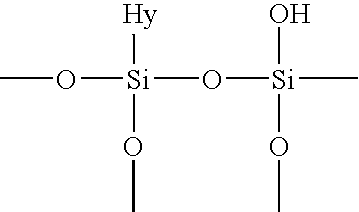Biochemical instrument having surface that inhibits nonspecific adsorption
a biochemical instrument and surface technology, applied in instruments, cellulosic plastic layered products, analysis material containers, etc., can solve the problems of insufficient inhibition of biopolymer or hydrophobic low-molecular weight compound adsorption, and achieve high crosslinking density, sufficient effect, and accelerate hydrolysis of metal alkoxide
- Summary
- Abstract
- Description
- Claims
- Application Information
AI Technical Summary
Benefits of technology
Problems solved by technology
Method used
Image
Examples
example 1
[0097]This example concerns adsorbing properties of proteins and hydrophobic low-molecular-weight compounds to various types of substrates.
(Preparation of Sample 1)
[0098]PMMA (VH, Mitsubishi Chemical Corporation) was subjected to melt-molding to prepare Sample 1.
(Preparation of Sample 2)
[0099]Polycarbonate (AD5503, Teijin Limited) was subjected to melt-molding to prepare Sample 2.
(Preparation of Sample 3)
[0100]Zeonex (330R, Zeon Corporation) was subjected to melt-molding to prepare Sample 3.
(Preparation of Sample 4)
[0101]A glass slide (S-1112, Matsunami Glass Ind., Ltd.) was used.
(Evaluation of Adsorbing Properties)
[0102]An aqueous solution of avidin FITC (5 μl, 0.25 mg / ml, pH 5.0, acetate), which is a fluorescent protein, or a solution of hydrophobic compound 1 in methanol (1 μl, concentration: 0.6%) was added dropwise to Samples 1 to 4, and the resultants were allowed to stand at room temperature for 5 minutes, followed by washing with ultrapure water. The fluorescent intensity of...
example 2
[0104]This example concerns adsorbing properties of proteins and hydrophobic low-molecular-weight compounds, when a region that inhibits adsorption of a hydrophobic low-molecular-weight compound and a region that inhibits adsorption of a biopolymer of the present invention are provided on a glass.
(Preparation of Sample 5)
Solution A:
[0105]Solution A: Ethanol (54.9 g), acetylacetone (2.46 g), and tetraethoxy titanium (2.82 g) were added to a 100-ml beaker, the mixture was agitated at room temperature for 10 minutes, 0.45 g of ultrapure water was added thereto, and the resultant was agitated at room temperature for an additional 60 minutes to prepare a catalyst solution.
[0106]Solution B: Ultrapure water (44.12 g) and Polymer 7 (n=31, 1.73 g) were added to a 100-ml beaker, the mixture was agitated to dissolve the polymer therein, and Solution A (10.10 g) and tetramethoxysilane (5.20 g) were added, followed by agitation.
[0107]Ultrapure water (1.0 g) was added to Solution B (3.23 g), the ...
example 3
[0111]This example concerns adsorbing properties of proteins and hydrophobic low-molecular-weight compounds to a surface prepared by forming a thin SiO2 layer as an adhesion layer on a plastic surface and then forming a region that inhibits adsorption of a hydrophobic low-molecular-weight compound and a region that inhibits adsorption of a biopolymer of the present invention thereon.
(Preparation of Sample 7)
[0112]Sample 1 was subjected to vacuum deposition with SiO under an oxygen atmosphere to form a 100-nm SiO2film. Further, Sample 7 was obtained in the same manner as in the case of Sample 6.
(Preparation of Sample 8)
[0113]Sample 8 was obtained in the same manner as in the case of Sample 7, except that Sample 1 was replaced with Sample 2.
(Preparation of Sample 9)
[0114]Sample 9 was obtained in the same manner as in the case of Sample 7, except that Sample 1 was replaced with Sample 3.
(Evaluation of Adsorbing Properties)
[0115]Samples 7 to 9 were subjected to the same evaluation as in...
PUM
| Property | Measurement | Unit |
|---|---|---|
| Fraction | aaaaa | aaaaa |
| Angle | aaaaa | aaaaa |
| Weight | aaaaa | aaaaa |
Abstract
Description
Claims
Application Information
 Login to View More
Login to View More - R&D
- Intellectual Property
- Life Sciences
- Materials
- Tech Scout
- Unparalleled Data Quality
- Higher Quality Content
- 60% Fewer Hallucinations
Browse by: Latest US Patents, China's latest patents, Technical Efficacy Thesaurus, Application Domain, Technology Topic, Popular Technical Reports.
© 2025 PatSnap. All rights reserved.Legal|Privacy policy|Modern Slavery Act Transparency Statement|Sitemap|About US| Contact US: help@patsnap.com



